Chapter: Mechanical : Automobile Engineering : Transmission Systems
Clutch
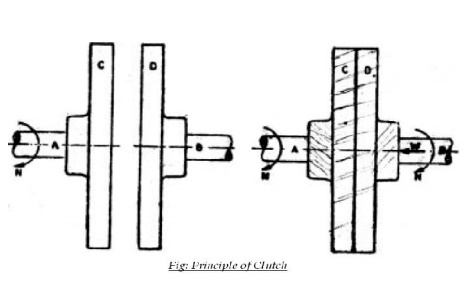
Clutch
Clutch is a device which is used in the transmission system of
automobile to engage and disengage the engine to the transmission or gear box.
It is located between the transmission and the engine. When the clutch is
engaged, the power flows from the engine to the rear wheels in a
rear-wheel-drive transmission and the vehicle moves. When the clutch is
disengaged, the power is not transmitted from the engine to the rear wheels and
vehicle stops even if engine is running.
It works on the principle of friction. When two friction
surfaces are brought in contact with each other and they are united due to the
friction between them. If one is revolved the other will also revolve.
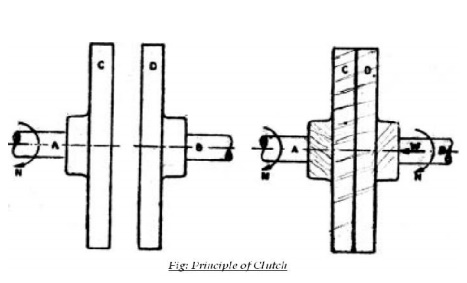
The friction depends upon the surface area contact. The
friction surfaces are so designed that the driven member initially slips on
driving member when initially pressure is applied. As pressure increases the
driven member is brought gradually to speed the driving member.
The three main parts of clutch
are:
·
Driving member
·
Driven member
·
Operating member
The driving member consists of a flywheel mounted on the
engine crank shaft. The flywheel is bolted to cover which carries a pressure
plate or driving disc, pressure springs and releasing levers. Thus the entire
assembly of flywheel and cover rotates all the times. The clutch housing and
the cover provided with openings dissipate the heat generated by friction
during the clutch operation.
The driving member consists of a disc or plate called clutch
plate. It is free to slide length wise on the splines of the clutch shaft. It
carries friction materials on both of its surfaces when it is gripped between
the flywheel and the pressure plate; it rotates the clutch shaft through
splines.
The operating members consists of a foot pedal, linkage,
release or throw-out bearing, release levers and springs necessary to ensure
the proper operation of the clutch.
Now the driving member in an automobile is flywheel mounted on
crank shaft, the driven member is the pressure plate mounted on transmission or
gear box input shaft. Friction surfaces or clutch plates is placed between two
members.
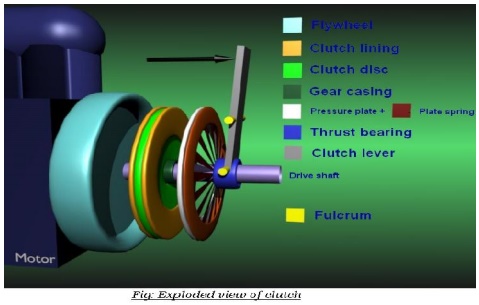
Types of Friction Materials:
The
friction materials of the clutch plate are generally of 3 types:
·
Mill Board Type
·
Molded type
·
Woven type
Mill Board type friction materials mainly include asbestos
material with different types of impregnates.
Molded type friction materials are made from a matrix of
asbestos fiber and starch or any other suitable binding materials. They are
then heated to a certain temperature for moulding in dies under pressure. They
are also made into sheets by rolling, pressing and backs till they are
extremely hard and dense. Metallic wires are used sometimes to increase wear
properties.
Woven types facing materials are made
by impregnating a cloth with certain binders or by weaving threads of copper or
brass wires covered with long fiber asbestos and cotton. The woven sheets
treated with binding solution are baked and rolled.
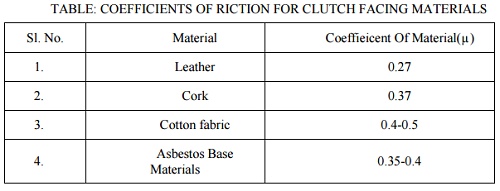
Properties
Of Good Clutching:
·
Good Wearing Properties
·
High Resistance to heat
·
High coefficient of friction
·
Good Binders in it
Operation
Of Clutch:
When the clutch pedal is pressed
through pedal movement, the clutch release bearing presses on the clutch
release lever plate which being connected to clutch release levers, forces
these levers forward. This causes the pressure plate to compress pressure springs,
thus allowing it to move away from the clutch driven plate. This action
releases the pressure on the driven plate and flywheel, the flywheel is now
free to turn independently, without turning the transmission.
When the clutch pedal is released, reverse action takes place
i.e. the driven plate is again forced against the flywheel by the pressure
plate- because of the force exerted by pressure springs. The pressure plate
will keep on pressing the facings of driven plate until friction created
becomes equal to the resistance of the vehicle. Any further increase in
pressure will cause the clutch plate and the transmission shaft to turn along
with flywheel, thus achieving vehicle movement.
1.Single Clutch Plate:
It is the most common type of clutch plate used in motor
vehicles. Basically it consists of only one clutch plate, mounted on the
splines of the clutch plate. The flywheel is mounted on engine crankshaft and
rotates with it. The pressure plate is bolted to the flywheel through clutch
springs, and is free to slide on the clutch shaft when the clutch pedal is
operated. When the clutch is engaged the clutch plate is gripped between the
flywheel and pressure plate. The friction linings are on both the sides of the
clutch plate. Due to the friction between the flywheel, clutch plate and the
pressure plate the clutch plate revolves the flywheel. As the clutch plate
revolves the clutch shaft also revolves. Clutch shaft is connected to the
transmission gear box. Thus the engine power is transmitted to the crankshaft
and then to the clutch shaft.
When the clutch pedal is pressed, the pressure plate moves
back against the force of the springs, and the clutch plate becomes free
between the flywheel and the pressure plate. Thus the flywheel remains rotating
as long as the engine is running and the clutch shaft speed reduces slowly and
finally it stops rotating. As soon as the clutch pedal is pressed, the clutch
is said to be engaged, otherwise it remains engaged due to the spring forces.
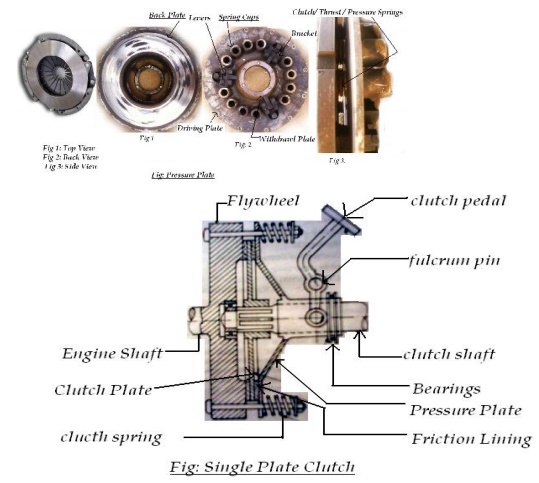
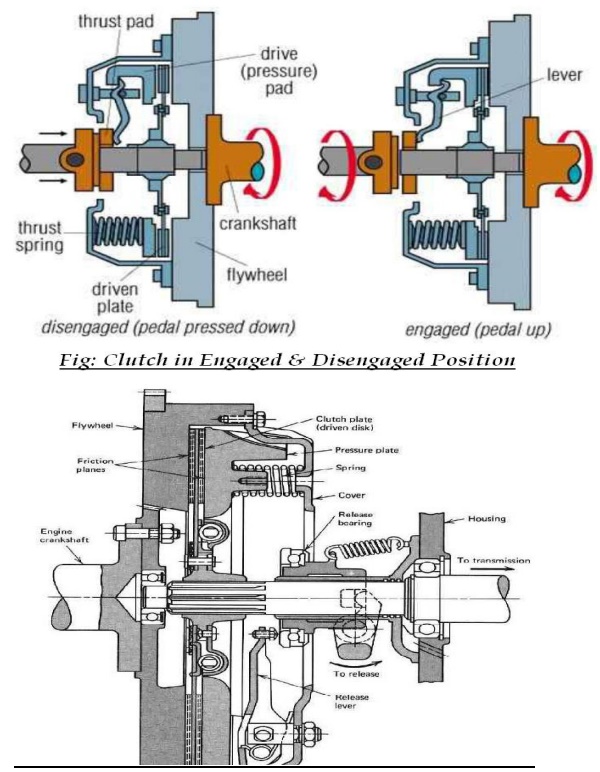
2.Multi-plate Clutch:
Multi-plate clutch consists of a number of clutch plates
instead of only one clutch plate as in case of single plate clutch. As The
number of clutch plates are increased, the friction surfaces also increases.
The increased number of friction surfaces obliviously increases the capacity of
the clutch to transmit torque.
The plates are alternately fitted to engine and gear box
shaft. They are firmly pressed by strong coil springs and assembled in a drum.
Each of the alternate plate slides on the grooves on the flywheel and the other
slides on splines on the pressure plate. Thus, each alternate plate has inner
and outer splines.
The multi-plate clutch works in the same way as a single plate
clutch by operating the clutch pedal. The multi-plate clutches are used in
heavy commercial vehicles, racing cars and motor cycles for transmitting high
torque. The multi-plate clutch may be dry or wet. When the clutch is operated
in an oil bath, it is called a wet clutch. When the clutch is operated dry it
is called dry clutch. The wet clutch is used in conjunction with or part of the
automatic transmission.
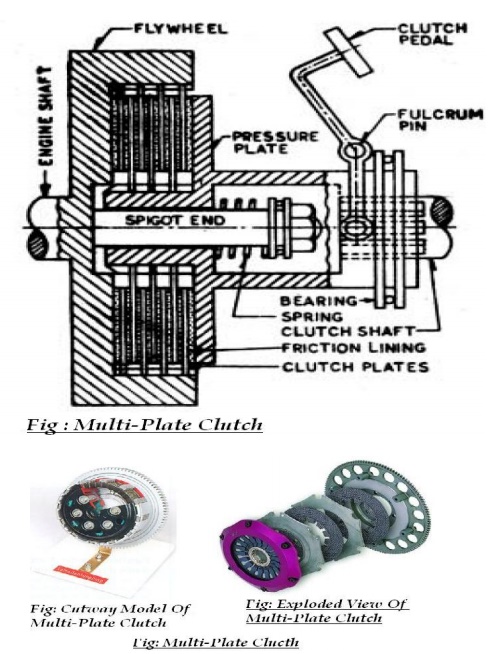
3.Cone Clutch:
Cone clutch consists of friction surfaces in the form of cone.
The engine shaft consists of female cone. The male cone is mounted on the
splined clutch shaft. It has friction surfaces on the conical portion. The male
cone can slide on the clutch shaft. Hen the clutch is engaged the friction
surfaces of the male cone are in contact with that of the female cone due to
force of the spring. When the clutch pedal is pressed, the male cone slides
against the spring force and the clutch is disengaged.
The only advantage of the cone clutch is that the normal force
acting on the friction surfaces is greater than the axial force, as compare to
the single plate clutch in which the normal force acting on the friction
surfaces is equal to the axial force. The disadvantage in cone clutch is that
if the angle of the cone is made smaller than 200 the male cone tends to bind
in the female cone and it becomes difficult to disengage the clutch. Cone
clutches are generally now only used in low peripheral speed applications
although they were once common in automobiles and other combustion engine
transmissions. They are usually now confined to very specialist transmissions
in racing, rallying, or in extreme off-road vehicles, although they are common
in power boats. Small cone clutches are used in synchronizer mechanisms in
manual transmissions.

4.Dog & Spline Clutch:
This type of clutch is used to lock two shafts together or to
lock a gear to shaft. It consists of a sleeve having two sets of internal
splines. It slides on a splined shaft with smallest diameter splines. The
bigger diameter splines match with the external dog clutch teeth on driving
shaft. When the sleeve is made to slide on the splined shaft, its teeth match
with the dog clutch teeth of the driving shaft. Thus the sleeve turns the
splined shaft with the driving shaft.
The clutch is said to be engaged. To disengage the clutch, the
sleeve is moved back on the splined shaft to have no contact with the driving
shaft. This type of clutch has no tendency to slip. The driven shaft revolves
exactly at the same speed of the driving shaft, as soon as the clutch is
engaged. This is also known as positive clutch.
5. Centrifugal Clutch:
The centrifugal clutch uses centrifugal forces, instead of
spring force for keeping it in engaged position. Also, it does not require
clutch pedal for operating the clutch. The clutch is operated automatically
depending on engine speed. The vehicle can be stopped in gear without stalling
the engine. Similarly the gear can be started in any gear by pressing the
accelerator pedal.
A centrifugal clutch works through centrifugal force. The
input of the clutch is connected to the engine crankshaft while the output
drives gear box shaft, chain, or belt. As engine R.P.M. increases, weighted
arms in the clutch swing outward and force the clutch to engage. The most
common types have friction pads or shoes radially mounted that engage the
inside of the rim of housing.
On the center shaft there are an assorted amount of extension
springs, which connect to a clutch shoe. When the center shaft spins fast
enough, the springs extend causing the clutch shoes to engage the friction
face. It can be compared to a drum brake in reverse. The weighted arms force
these disks together and engage the clutch.
When the engine reaches a certain RPM, the clutch activates,
working almost like a continuously variable transmission. As the load increases
the R.P.M. drops thereby disengaging the clutch and letting the rpm rise again
and reengaging the clutch. If tuned properly, the clutch will tend to keep the
engine at or near the torque peak of the engine.
These results in a fair bit of waste heat, but over a broad
range of speeds it is much more useful then a direct drive in many
applications. Weaker spring/heavier shoes will cause the clutch to engage at a
lower R.P.M. while a stronger spring/lighter shoes will cause the clutch to
engage at a higher R.P.M.
Semi-centrifugal Clutch:-
A semi centrifugal clutch is used to transmit power from high
powered engines and racing car engines where clutch disengagements requires
appreciable and tiresome drivers effort. The transmission of power in such
clutches is partly by clutch springs and rest by centrifugal action of an extra
weight provided in system. The clutch springs serve to transmit the torque up
to normal speeds, while the centrifugal force assists at speeds higher than
normal.
Besides
clutch, pressure plate and splines shaft it mainly consists of:
Compression
spring (3 numbers)
Weighted
levers (3 numbers)
At normal speeds when the power transmission is low the spring
keeps the clutch engaged, the weighted levers do not have any pressure on the
pressure plate. At high speed, when the power transmission is high the weights
fly off and levers exert pressure on the plate which keeps the clutch firmly
engaged. Thus instead of having more stiff springs for keeping the clutch
engaged firmly at high speeds, they are less stiff, so that the driver may not
get any strain in operating the clutch.
when the speed decreases, the weights fall and the levers do
not exert any pressure on the pressure plate. Only the spring pressure is
exerted on the pressure plate which is sufficient to keep the clutch engaged.
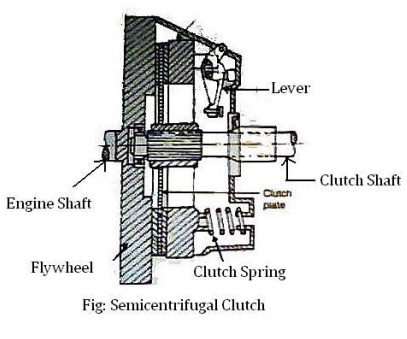
6. Electromagnetic Clutch:
An electromagnetic clutch is a clutch (a mechanism for
transmitting rotation) that is engaged and disengaged by an electromagnetic
actuator. In this type of clutch, the flywheel consists of winding. The current
is supplied to the winding from battery or dynamo.
When the current passes through the winding it produces an
electromagnetic field which attracts the pressure plate, thereby engaging the
clutch. When supply is cutoff, the clutch is disengaged. The gear lever
consists of a clutch release switch. When then the driver holds the gear lever
to change the gear the witch is operated cutting off the current to the winding
which causes the clutch disengaged. At low speeds when the dynamo output is
low, the clutch is not firmly engaged.
Therefore three springs are also provided on the pressure
plate which helps the clutch engaged firmly at low speed also. Cycling is
achieved by turning the voltage/current to the electromagnet on and off.
Slippage normally occurs only during acceleration. When the clutch is fully
engaged, there is no relative slip, assuming the clutch is sized properly, and
thus torque transfer is 100% efficient.
The electromagnetic clutch is most suitable for remote
operation since no linkages are required to control its engagement. It has
fast, smooth operation. However, because energy dissipates as heat in the
electromagnetic actuator every time the clutch is engaged, there is a risk of
overheating. Consequently the maximum operating temperature of the clutch is
limited by the temperature rating of the insulation of the electromagnet. This
is a major limitation. Another disadvantage is higher initial cost.

Related Topics